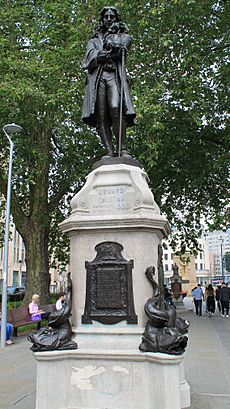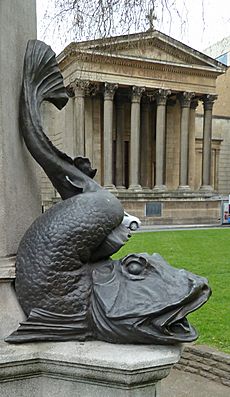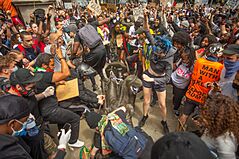Statue of Edward Colston facts for kids
Quick facts for kids Statue of Edward Colston |
|
|---|---|

The statue in 2019
|
|
| Artist | John Cassidy |
| Completion date | 13 November 1895 |
| Medium | Bronze |
| Subject | Edward Colston |
| Condition | Figure toppled, damaged and removed; plinth defaced by demonstrators |
| Location | Bristol, England |
|
Listed Building – Grade II
|
|
| Official name | Statue of Edward Colston |
| Designated | 4 March 1977 |
| Reference no. | 1202137 |
The statue of Edward Colston was a bronze statue of Edward Colston (1636–1721). He was a merchant born in Bristol, England. Part of his wealth came from the trans-Atlantic slave trade.
The statue was made in 1895 by Irish sculptor John Cassidy. It used to stand on a stone base in a public area called "The Centre" in Bristol. In 2020, anti-racism protestors pulled it down.
The statue was listed as a Grade II historic structure in 1977. However, it caused debate because of Colston's role in the Atlantic slave trade. He was a senior leader of the Royal African Company. From the 1990s, people started to question if it was right to honor Colston. In 2018, Bristol City Council wanted to add a new sign to explain Colston's link to slavery. But they disagreed on what the sign should say.
On June 7, 2020, the statue was pulled down. It was covered in paint and pushed into Bristol Harbour. This happened during the George Floyd protests. These protests were part of the Black Lives Matter movement. The statue's base was also covered in graffiti but it is still there. Bristol City Council took the statue out of the harbor on June 11, 2020. It was then stored away. It was shown at the M Shed museum in 2021 with the graffiti still on it. It became a permanent exhibit in March 2024. Four people involved in the toppling were later found not guilty by a jury in January 2022.
Contents
What the Statue Looked Like
The monument was made of a bronze statue of Edward Colston. It was about 8 feet 8 inches (2.64 meters) tall. This statue stood on a stone base that was 10 feet 6 inches (3.2 meters) high.
The statue showed Colston wearing clothes typical of his time. He had a long wig, a velvet coat, a satin waistcoat, and knee-breeches. The base was made of Portland stone. It had bronze plaques and dolphin figures on each corner.
There were four plaques on the base, one on each side. Three of them were relief sculptures in an Art Nouveau style. Two showed scenes from Colston's life. The third showed a sea fantasy. The plaque on the south side said: "Erected by citizens of Bristol as a memorial of one of the most virtuous and wise sons of their city AD 1895" and "John Cassidy fecit" (John Cassidy made this).
Why the Statue Was There
Who Was Edward Colston?
Edward Colston was a merchant from Bristol. He earned a lot of his money from the slave trade. This was especially true between 1680 and 1692. He was an active member of the Royal African Company. For a short time, he was even its deputy governor. During his time, the Company moved about 84,000 enslaved people from West Africa to the Americas.
Colston used his wealth to help many charities. He supported almshouses, hospitals, schools, and churches. He helped places all over England, especially in Bristol. He was also a Member of Parliament for Bristol from 1710 to 1713. After he died, he left £71,000 to charities. He also left £100,000 to his family.
In the 1800s, people saw him as a great helper of others. The fact that some of his money came from the slave trade was mostly ignored. This changed in the 1990s.
How the Statue Came to Be
The statue was designed by Irish sculptor John Cassidy. It was put up in 1895 to remember Colston's good deeds. It was placed in the area now called The Centre.
The idea for the statue came in October 1893 from James Arrowsmith. He was the president of the Anchor Society. In March 1894, a group was formed to raise money for it. Some people believe the Colston statue was put up after another statue appeared nearby. That statue was of Edmund Burke, who had criticized Bristol's role in the slave trade.
Two groups linked to Colston's charities gave £407 for the statue. More money, up to £650, was raised from the public after the statue was revealed. This included money from the Society of Merchant Venturers. Sculptors sent 23 models to the committee. Cassidy's design was chosen.
The statue was revealed on November 13, 1895. The mayor, Howell Davies, and the bishop of Bristol, Charles Ellicott, were there. This day was known as Colston Day in the city.
The statue was officially listed as a Grade II historic structure on March 4, 1977. Historic England called the statue "handsome." They said its mix of styles was handled well. They also noted it fit well with other memorials nearby. These included the statue of Edmund Burke and the Cenotaph.
The Toppling and Removal
On June 7, 2020, during worldwide protests after the murder of George Floyd in the United States, the statue was pulled down. Demonstrators jumped on it. They painted it red and blue. One protester was seen kneeling on the statue's neck. This was a reference to how George Floyd died. The statue was then rolled down Anchor Road and pushed into Bristol Harbour. Before this, a petition to remove the statue had received over 11,000 signatures.
Police Superintendent Andy Bennett said they decided not to stop the act. They were worried that stopping it could lead to more violence. He also said that damaging the statue was against the law. He confirmed there would be an investigation to find those involved.
What People Said
On June 7, 2020, the Home Secretary, Priti Patel, called the toppling "utterly disgraceful." She said it was "completely unacceptable" and "sheer vandalism." She felt it took away from the protest's main message. The Mayor of Bristol, Marvin Rees, said her comments showed a "lack of understanding."
On June 8, Mayor Rees said the statue was offensive. He felt no "sense of loss" when it was removed. But he said the statue would be taken out of the water. He thought it would likely end up in a museum. The historian David Olusoga said the statue should have been removed earlier. He explained that statues are meant to honor "great men." He added, "That is not true, he [Colston] was a slave trader and a murderer."
Police Superintendent Andy Bennett also said he understood that Colston was "a historical figure that's caused the black community quite a lot of angst." He added, "Whilst I am disappointed that people would damage one of our statues, I do understand why it's happened, it's very symbolic."
Mayor Rees said it was important to listen to those who found the statue offensive. He wanted the event to help the city fight racism and inequality. He told Krishnan Guru-Murthy: "We have a statue of someone who made their money by throwing our people into water ... and now he's on the bottom of the water."
A spokesperson for Boris Johnson, the Prime Minister, said he understood people's strong feelings. But he said the proper process should have been followed. He believed police should hold those involved responsible.
Labour leader Keir Starmer said pulling the statue down was "completely wrong." But he also said it should have been removed "a long, long time ago." He added, "you can't, in 21st Century Britain, have a slaver on a statue. That statue should have been brought down properly, with consent, and put in a museum."
The Society of Merchant Venturers said on June 12, 2020, that the statue's removal was "right for Bristol." They said to fight racism, the city must face its past. This includes removing statues that honor someone who profited from trading human lives.
A direct descendant of Colston, Philip Colston Robins, wrote to the Mayor of Bristol. He suggested the city should "make peace with the past." This could include helping cities in West Africa affected by the slave trade.
Retrieving and Storing the Statue
At 5 AM on June 11, 2020, Bristol City Council took the statue out of Bristol Harbour. The statue was full of mud and dirt from the harbor floor. The council said the statue was still strong. But it had lost one of its coattails and its walking stick. It also had damage to its left side and foot.
They cleaned the statue to stop it from rusting. They planned to show it in a museum. They decided not to remove the graffiti and ropes put on it by the protesters. While cleaning, they found an 1895 magazine inside the statue. It had the date October 26, 1895, and the names of the people who first put the statue together.
Police Investigation
The day after the statue was toppled, police said they had found 17 people linked to the event. But they had not yet arrested anyone. On June 22, 2020, police shared pictures of people connected to the event. They asked the public for help to identify them.
On July 1, a 24-year-old man was arrested. He was later released while police continued their investigation. In September 2020, police said they had sent information about four people to the Crown Prosecution Service. This group decides if charges should be brought. Five other people were offered ways to make up for their actions, like a fine or community service. By October 1, 2020, six people had accepted these offers.
After the Toppling
On June 8, the day after the statue was pulled down, a cardboard sign was taped to the base. It said: "This plaque is dedicated to the slaves that were taken from their homes." This covered the bronze plaque that called Colston "virtuous and wise."
After Colston's statue was removed, a similar statue was taken down in east London. This was a statue of Robert Milligan, another slave trader. This happened on June 9, 2020. On the same day, the Mayor of London, Sadiq Khan, asked for London statues linked to slavery to be removed or renamed. Khan created a group to review London's landmarks.
People in Bristol continued to support or oppose the statue's removal. On June 17, the headstone of Scipio Africanus, an enslaved man, was damaged. This happened in a churchyard in Bristol. The attacker broke one of the stones and wrote a warning.
After Colston's statue was removed, a petition started. It asked for a statue of Paul Stephenson to be put in its place. Paul Stephenson is a black man who used to work with young people in Bristol. He was important in the 1963 Bristol Bus Boycott. This protest helped end a rule that stopped black people from working for Bristol bus companies.
The statue's base has stayed empty. But several unofficial statues have been placed on it.
- On July 11, 2020, a mannequin dressed as a TV presenter appeared on the base. It had a sign that said: "None of them stopped me, and your licence paid for it." The mannequin was there for about an hour before it was removed.
- On July 15, 2020, a statue by artist Marc Quinn was placed on the empty base without permission. The statue, called A Surge of Power (Jen Reid) 2020, shows a Black Lives Matter protester, Jen Reid, with a raised fist. Quinn called it a "new temporary, public installation." Bristol City Council removed the statue the next morning. It was returned to Quinn. An application to keep A Surge of Power for two years was denied in November 2021.
- On December 2, 2020, a small figure of Darth Vader appeared on the base. This was seen as a tribute to the actor David Prowse, who played Darth Vader and was born in Bristol. He had died on November 29, 2020.
What Happens Next and Where the Statue Is Now
In September 2020, Bristol Mayor Marvin Rees created the We Are Bristol History Commission. This group is independent. It helps Bristol understand its history better. It works with people to hear their views on the city's past. The group aims to build a shared understanding of Bristol's story for the future. A city council spokesperson said the commission would start by looking at the Colston statue. It would also look at wider historical issues in the city. Dr. Tim Cole leads the Commission. Some people felt the group had too many academics and not enough local community members.
The Colston statue was shown at the M Shed museum in Bristol from June 4 to September 5, 2021. It was displayed lying down on a wooden support. The graffiti remained on it. John Finch, from Bristol City Council, said it was displayed this way because it was "unstable" standing up. This also allowed visitors to see the graffiti and damage up close. Some protest signs were also displayed nearby. The museum said this display was "the start of a conversation." It asked people for their thoughts on the statue's future.
After the statue was put on display, some people who wanted it back on its base tried to stop others from seeing it. They booked all the free tickets but did not show up. The museum then changed its booking system. It allowed people to visit without booking if there was space. After the temporary exhibit closed, the History Commission looked at the public's responses.
On August 4, 2021, a planning inspector said no to putting Marc Quinn's statue of Jen Reid back on the base. He said that because the Colston statue was removed without permission, it was still legally part of the monument. He felt that replacing it with another statue would harm the monument's historical value.
On February 3, 2022, the We Are Bristol History Commission made a recommendation. After asking the public, they suggested the toppled Colston statue should be shown in the city's museum. It should be displayed as it is, with its graffiti. They also suggested that temporary artworks could be placed on the empty base, with times when it is left empty.
In March 2024, the statue, still defaced, went on permanent display. It is now part of an exhibit about protest at Bristol's M Shed museum.
See also
 In Spanish: Estatua de Edward Colston para niños
In Spanish: Estatua de Edward Colston para niños
- 1895 in art
- Actions against memorials in the United Kingdom during the George Floyd protests
- List of monuments and memorials removed during the George Floyd protests
- List of public statues of individuals linked to the Atlantic slave trade





